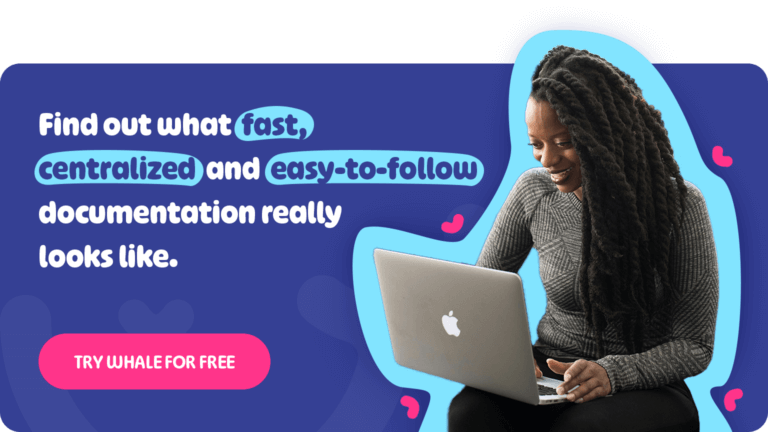Employee onboarding software helps onboard and train your teams.
But it can be overwhelming to try to decide which one is right for you and your team.
Don’t panic. We’ve compiled a list of 10 to help you.
Why is employee onboarding software important?
- Organizations with a strong onboarding process improve new hire retention by 82% and productivity by over 70%. (Brandon Hall Group)
- Companies that offer comprehensive training programs have 218% higher income per employee than companies without formalized training. (Association for Talent Development (ATD)
Without software, it’s difficult, if not impossible, to scale and to ensure the best onboarding and training experience for companies and teams.
We’ve compiled a comprehensive list of the 10 best software for onboarding and training employees for 2024.
Whether you’re a small startup or a global enterprise, these software options are poised to revolutionize your onboarding process, boost employee engagement, and maximize overall organizational success. Choose one of them and make sure you give your employees the best software onboarding experience possible.
The 10 Best employee onboarding software options in 2024
1. Whale
🏆Best all-encompassing employee onboarding and training tool for SMEs
Rated best for customer support and ease of use on G2, Whale is the easiest documentation and training tool out there. Centralize all your processes, SOPs, playbooks, and more — so you can quickly onboard, train, and set your team up for success.
Obviously, we can’t tell you how wonderful we are, so we asked our friends at CrazyEgg to do a review and got some of our customers to share their experiences instead.
This is what Whale customers love;
- Easy-to-use interface
- Custom learning paths
- Quizzes
- Built-in reporting and tracking
- Excellent automation
- Time-saving templates and AI
- Helpful browser extension
And what they don’t;
- My only feedback would be to make the quizes more detailed… but I still like their current format as it is useful as is!
- Nothing inparticular that I dislike about Whale but starting from scratch with all of our SOP’s was sort of overwhelming.
- It’s very manual to install the suggestions. Once everything is installed, it’s ep-ic but it can take some time so don’t wait long to do it. Start while you’re creating your documentation in Whale.
“The best onboarding tool that we ever used.”
Whale helps us a lot with streamlining our onboarding process. Whale just automates the assignment of different onboarding documents. We just add a new hire to a group, and the system does the rest for us.
2. Cegid Talentsoft
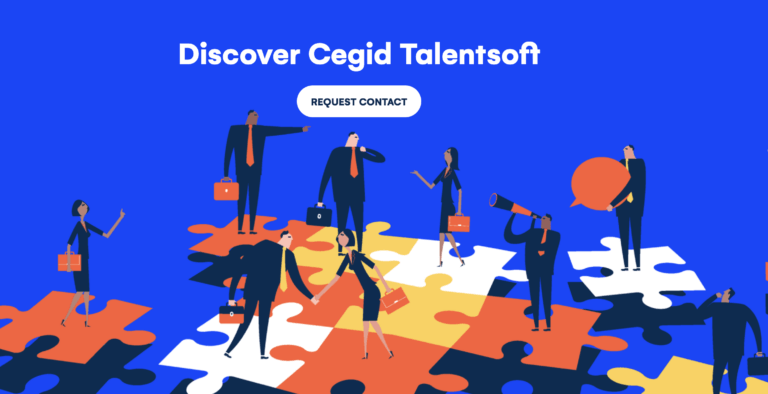
🏆 Best for Medium and large enterprises
Cegid Talentsoft is a full HR suite that supports your HR administration, talent acquisition, talent management and learning.
What we love…
- Cegid Talentsoft caters to a number of large well-established companies, including L’Oréal, Lacoste, and Miniso.
- The platform is available in multiple languages and services in more than 130 countries.
- Users can source talent, review and evaluate applicants, and store key information on their dashboards.
- The team collaboration tool helps team members streamline tasks, share candidate profiles, and reduce hiring errors.
- Cegid Talentsoft’s workforce management tool includes onboarding and succession planning.
What we don’t
- Cegid Talentsoft’s pricing is not readily available on their website.
- The platform does not offer a free trial.
- There is no live chat support available.
3. Docebo
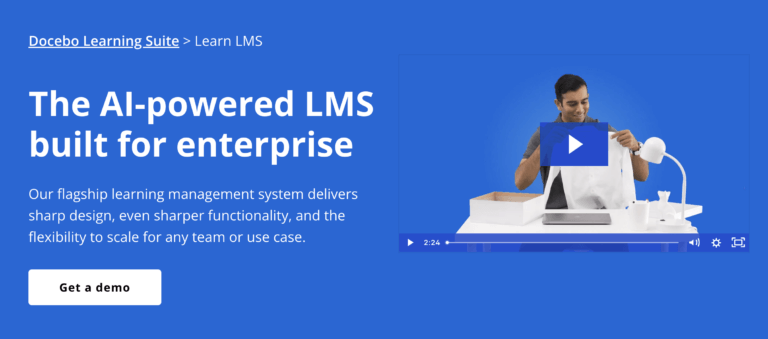
🏆Best LMS built for enterprise
Docebo is redefining the way enterprises leverage technology to create, deliver, and understand the business impact of their learning experiences through The Docebo Learning Suite.
With Docebo’s multi-product learning suite, enterprises around the world are equipped to tackle any learning challenge and create a true learning culture within their organization.
What we love…
- Speedy and professional support for feature requests
- Gamification for increased learning engagement
- AI-Powered Learning Engine
- Modern, neat user experience
What we don’t
- Not a great solution for small and medium-sized businesses
4. Bamboo HR
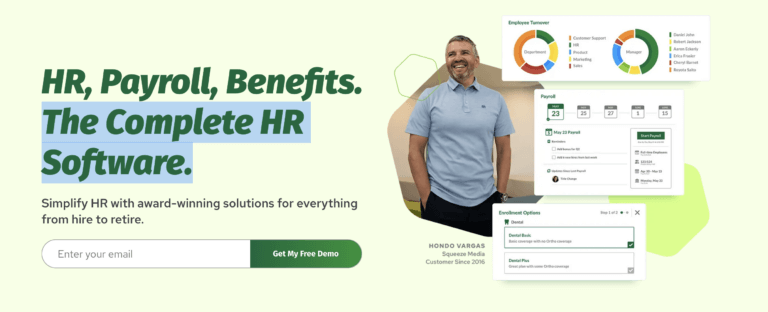
🏆Best for overall HR Software
Instead of using fragmented spreadsheets, limited or clunky software, and physical paper, BambooHR helps you centralize your data and automate the way you complete key HR tasks. As you hire, onboard, and pay your employees, every step of the process from hire to retire comes with automation that will help your team keep up with the demands of your changing market and workplace.
What we love…
- Platform fully dedicated to providing all modern HR tools a company needs for its HR department.
- Can run national and international payrolls.
- Manages tax and compliance.
- Ideal for building company culture.
- Helps businesses attract and retain talent.
What we don’t
- Not specifically designed for onboarding and training.
- No 24/7 support.
- Price not disclosed on the website.
5. Deel
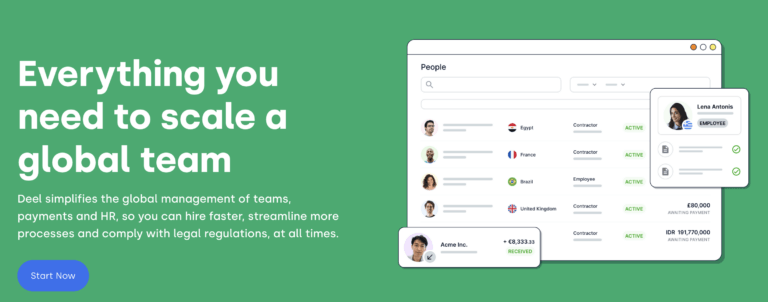
🏆 Best for remote teams needing additional assistance with cross-border legal compliance
Deel is the all-in-one HR platform for global teams. That means end-to-end HR management for any team, anywhere. Compliantly hire, onboard, and pay full-time employees or independent contractors in minutes. For the first time, you’ll have a central view of your entire workforce in one single place.
With Deel, companies make global payroll possible by leveraging Deel’s in-house back office and locally-owned entities. Workers, managers, and leaders can update withdrawal details, visualize team structure, oversee total payroll spending, and complete dozens of other tasks through Deel’s modern self-serve interface.
Today, Deel serves more than 15,000 customers from SMBs to publicly traded companies, helping over 120,000 workers get paid from anywhere.
What we love
- Quickly onboard global employees and contractors.
- Hassle-free global payroll in 90+ countries.
- EOR services to support rapid international scaling.
- Dedicated customer success manager for enterprise clients.
What we don’t
- EOR services are extensive but expensive.
- Focuses more on legal compliance than employee experience
- CSMs are only provided to enterprise clients.
6. iSpring
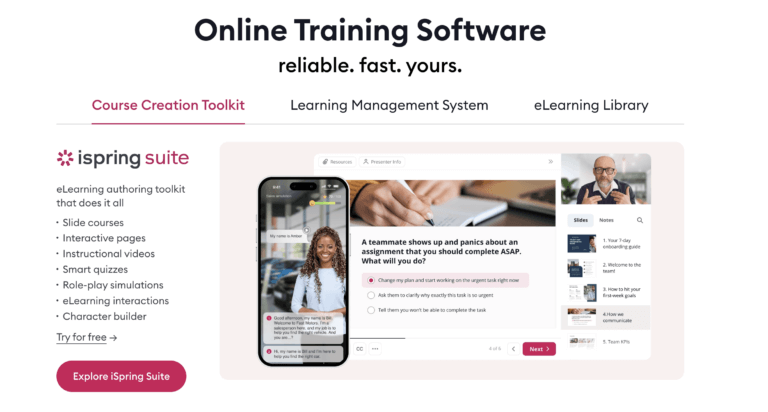
🏆Best for adding into existing LMS
iSpring Suite is a comprehensive authoring toolkit that lets you create professional eLearning content — interactive courses, quizzes, video tutorials, role-play simulations, SCORM-compliant e-books, and interactions. At the same time, it’s a user-friendly tool with virtually no learning curve — exactly what you need when working under a deadline.
iSpring Suite also comes with an extensive library of eLearning assets, Character builder, and templates for even faster course authoring and an online space in which you can store content, work on it together with your team, and share it with stakeholders for review and approval.
What we love…
- Very reasonable pricing
- Beginner-friendly and simple interface
- Enormous content library
- Beneficial and cautious support section
- 6 distinct programs included in the subscription
What we don’t
- Requires Microsoft Windows system with a PowerPoint license
- Cloud tool lacks needed capabilities
- Insufficient video editing features
7. Talent LMS
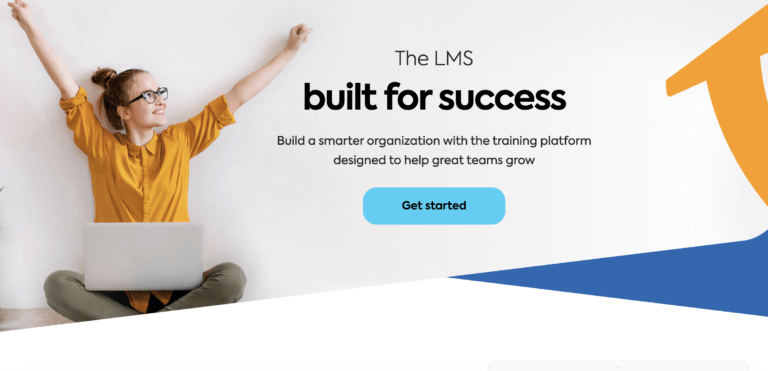
🏆Best for cost-effective stand alone LMS
TalentLMS is a cloud-based solution ideal for delivering engaging online training,
Major corporations like OYO, Delonghi, CP, Triton Aerospace, Hudl, and more trust TalentLMS in order to implement a successful training strategy.
With an experience that’s fully customizable and easy to manage, learners train while feeling right at home. TalentLMS makes it easy to provide the right training for any team and every use, while giving expert guidance and support every step of the way. On a mission to democratize training, TalentLMS already serves 70, 000+ teams worldwide.
What we love…
- A learning management system that is easy to use and implement
- Customizable to suit the needs of your organization
- Engaging and interactive interface for learners
- Social learning features for collaboration and knowledge sharing
What we don’t
- General Interface could be modernized/look better.
- Customization – making any changes to the interface and add items to the portal is not that easy
- Adding training content can be slightly clunky.
8. LearnUpon
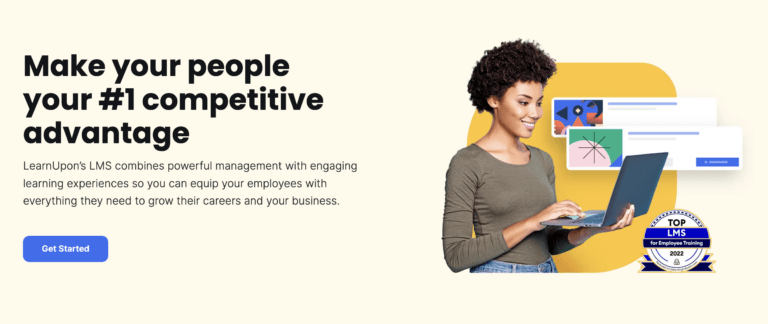
🏆Best for eCommerce
LearnUpon was founded on the belief that learning should be simple, and its impact should be big. And today, LearnUpon is helping 1,300+ businesses around the world with their in-house learning.
By championing simple, learner-centric experiences and results-focused support, LearnUpon gives teams the tools to deliver learning that impacts what matters – performance, retention, and growth.
What we love…
- Robust e-commerce offering.
- Gorgeous and neat user interface.
- Lovely learner portal.
- Live courses with multiple plugged-in vendors.
- Suitable for training companies and in-house trainers alike.
What we don’t
- Quizzing options are lacking.
- Module-based course creation requires more data input and tabbing than should be required.
9. Talmundo
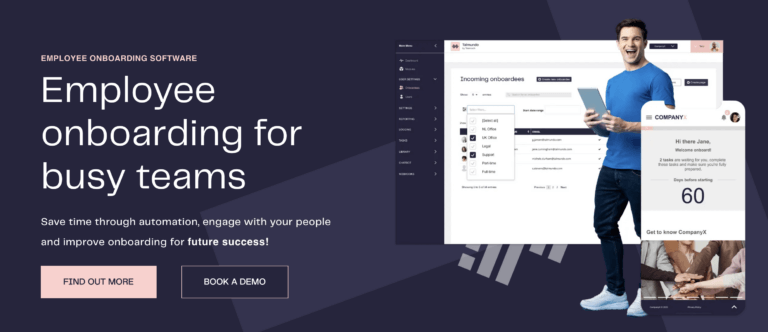
🏆Best for managing employee transitions, whether onboarding or offboarding.
Talmundo was built with the specific aim of revolutionizing the employee onboarding process. Founded in 2012, Talmundo aims to modernize and simplify onboarding activities with employee experience as the main driver.
One of the best things about this software is how fast to implement it is. Programming and customizing your employee’s roadmap is super straightforward, so you’ll be up and running in no time.
What we love…
- It is straightforward and very easy to implement in an organization
- The software covers both the pre-boarding and onboarding stages
- Onboardees can easily train themselves using the values set by you on the software
What we don’t
- Difficulty integrating this software with some other platforms
- The interface could use some improving
10. Workday
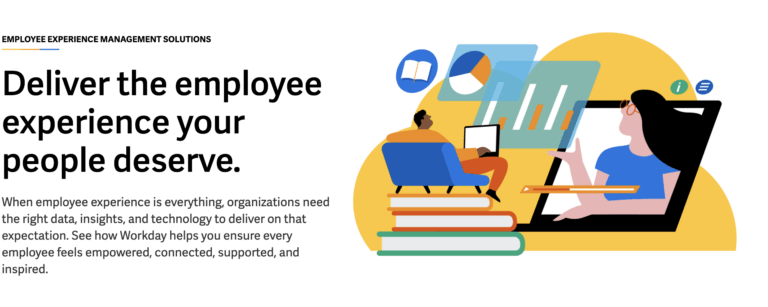
🏆 Best for total HR workforce management.
Workday HCM is a single, cloud-based solution for workforce planning, talent management, and employee experience, helping customers adapt and thrive in a changing world. Workday applications are built with artificial intelligence and machine learning at the core to help organizations around the world embrace the future of work. Workday is used by more than 10,000 organizations around the world and across industries—from medium-sized businesses to more than 50% of the Fortune 500.
What we love…
- Known for its ease of use and intuitive user interface
- Customizable options
- Offers adequate integration to other third-party apps
- Customer support via phone and online
What we don’t
- Not a great solution for small and medium-sized businesses
How to choose the best onboarding software?
Not all software was created equal! 🙃
So before you begin your search for the perfect onboarding software, know what it is exactly that you’re looking for.
It’s important to note that many software solutions may offer a combination of onboarding AND training features or fall into multiple categories. The choice of software depends on your specific needs, industry, training goals, and available resources.
1. Learning Management Systems (LMS)
Learning Management Systems are software platforms that help organizations deliver, track, and manage training programs and educational content. LMSs often offer features like course creation, content management, learner tracking, assessments, and reporting.
They provide a centralized hub for training materials and enable organizations to create structured training programs for new employees.
2. Knowledge Management Systems or centralized company databases
Picture all your company information in one centralized location 🥰. And imagine that anyone, irrespective of location or position or time of day, can access the information to help them complete a certain process or for learning. That’s a knowledge management system.
When integrated with the apps that your team works on, as Whale does, they store, categorize, and share information, turning your team into superheroes.
3. Learning Experience Platform (LXP)
Learning Experience Platforms focus on delivering a personalized and engaging learning experience for employees. LXPs often incorporate features like social learning, content curation, gamification, and multimedia elements to enhance the learning process.
They prioritize self-directed learning and encourage employees to explore resources based on their individual needs and interests.
4. Specific Employee Onboarding Software
Onboarding software focuses specifically on streamlining the employee onboarding process for new team members. It’s not simply about having an employee handbook. These tools provide a centralized platform for new employees to access training materials, complete necessary forms, and interact with their colleagues and mentors.
Such tools also often automate administrative tasks, such as new hire paperwork, policy acknowledgment, and equipment provisioning.
5. Performance Management Software
Performance management software is designed to improve business performance by tracking and incentivizing employee productivity in relation to specific goals. It works to ensure individual employees and teams are engaged and in alignment with the organization’s goals.
Ultimately the focus is performance, goals, output, and productivity.
Why should we invest in employee onboarding software?
Let’s face it, no one wants to start a new job where nothing is organized. Just as no one wants to work for an organization where everything relies on manual input. Software is the key to great employee experience and to scaling.
The benefits of great onboarding software contribute to a more effective and efficient onboarding and training process, leading to increased productivity, employee satisfaction, and overall organizational success.
- Streamlined and automated Onboarding: Software automates and standardizes the onboarding process, ensuring a consistent and efficient experience for new hires and reducing stress in the onboarding process for HR teams and hiring managers.
- Improved Employee Engagement: Interactive and engaging training materials keep employees interested and motivated, leading to higher engagement levels.
- Enhanced Knowledge Retention: Well-designed training programs with multimedia elements and reinforcement tools help combat the forgetting curve and help employees retain information more effectively.
- Time and Cost Savings: Automation reduces manual administrative tasks, saving time for HR teams and reducing costs associated with traditional training methods.
- Scalability and Consistency: Software allows organizations to scale training efforts easily, ensuring consistent training experiences across multiple locations or departments.
- Real-Time Performance Tracking: Analytics and reporting features provide insights into employee progress, enabling organizations to identify skill gaps and provide targeted support.
- Compliance and Risk Management: Training software helps organizations stay compliant with industry regulations, reducing the risk of legal and safety issues.
- Remote Accessibility: With remote work becoming more prevalent, employee onboarding and training software enables remote access to training materials, fostering flexibility and inclusivity.
How to evaluate employee onboarding software?
The above platforms offer various features for employee onboarding and training, such as creating and delivering interactive courses, tracking progress, assessments, and reporting. It’s important, however, to carefully evaluate each platform based on your specific requirements, budget, scalability, ease of use, and integration capabilities before making a decision.
When selecting an employee onboarding and training software, there are several important criteria you should consider.
Here are some key factors to evaluate:
Is the software user friendly?
The software should have an intuitive interface that is easy for both administrators and employees to navigate. This isn’t about pretty design, it’s about useability. A user-friendly system ensures efficient onboarding and training processes.
Is it customizable?
Look for software that allows you to tailor the onboarding and training experience to your organization’s specific needs. The ability to customize content, workflows, and branding will enhance the software’s effectiveness.
Does it have content Creation and Management capability?
The software should support the creation and management of various types of training content, such as videos, documents, quizzes, and interactive modules. It should also offer content versioning, collaboration features, and easy updating capabilities.
Can it scale as you do?
Consider whether the software can accommodate your organization’s growth. It should be capable of handling a large number of employees, departments, and training materials without compromising performance. HINT – the pricing of the tool should only increase when the size of your team does!
Can it integrate with other software?
Check if the software integrates flawlessly with the existing software your organization uses, such as performance management or other operational systems. Integration streamlines data flow and improves the overall employee experience.
Does it have a mobile application?
With the increasing use of mobile devices, it is beneficial to have a software solution that supports mobile access or has a mobile app. This allows employees to access training materials and complete onboarding tasks conveniently from their smartphones or tablets.
Does it give you analytics and reporting?
Robust analytics and reporting features are valuable for tracking the progress and effectiveness of employee onboarding and training. Look for software that provides detailed metrics, user insights, and progress reports to assess engagement and identify areas for improvement.
Does the platform have support and training?
While you’re onboarding new employees, who is onboarding you?! Consider the level of support and training provided by the software vendor. Look for resources such as documentation, tutorials, and customer support options to help you and your team make the most of the software.
Can it be accessed remotely?
In today’s hybrid and remote environment, you can’t have onboarding and training documentation available in just one on-site location. Users should have access to information irrespective of time zone or location, or device!
Does it have workflow automation?
A coherent onboarding and training software should automate workflows eliminating redundant steps and unnecessary manual tasks. In this way, HR teams and hiring managers can oversee the onboarding process across all departments and ensure everything is carried out seamlessly.
Does it provide return on investment (ROI)?
The objective of investing in a new tool should be to spend money to make money. Evaluate the software’s pricing structure and consider the potential return on investment (ROI). While cost is an important factor, it should be weighed against the software’s features, functionality, and long-term benefits for your organization.
By carefully considering these criteria, you can choose an employee onboarding and training software that aligns with your organization’s needs, enhances the learning experience, and contributes to the overall success of your workforce development initiatives.
Questions to ask before you buy an employee onboarding software solution
Remember how you used to enter a store, and it’d have a sign saying, “You broke it, you bought it!”.
Well, thank goodness it isn’t like that anymore! Now you CAN try before you buy and there’s no worry because you can’t break it.
But before you consider purchasing any of these solutions, it’s important to know what criteria are absolutely essential for your business.
- Is the solution’s interface easy to use?
- Does the solution integrate into other platforms?
- Does the solution provider have any credibility?
- What kind of ROI can I expect from this solution? Any tool you invest in needs to either save time or financial resources and ideally both!
- Can the software be customized to match our organization’s branding and specific needs? Check if the software allows for personalization, including branding elements, workflows, and content.
- Does the solution provide insights and reporting?
- Are automated workflows possible within the solution?
- What is the user experience like for both administrators and employees? Request a demo or trial to evaluate the software’s user-friendliness and ease of navigation for different user roles.
- Does the solution provide customer onboarding and support? Determine the available support channels, response times, and if training resources or documentation are available to assist your team.
- How does the software support mobile access? Inquire about mobile compatibility and whether employees can access training materials and complete tasks on smartphones or tablets.
FAQs about employee onboarding and training software
What features define the best onboarding software?
The best onboarding software typically possesses several key features:
- Customizable Onboarding Workflows
- Automation ability
- Integration Capabilities
- Analytics and Reporting
Take a trial or if you’re an enterprise-level client, be sure to book a demo with the service provider to see that the software fits your specifications.
How does onboarding software simplify the onboarding process?
Onboarding software simplifies the onboarding process in several ways:
Efficiency: By automating repetitive tasks and centralizing onboarding activities, software reduces the time and effort required to onboard new hires.
Consistency: Standardized workflows ensure a consistent onboarding experience for all employees, regardless of location or department.
Compliance: Compliance features help organizations adhere to legal and regulatory requirements by ensuring that necessary paperwork is completed accurately and on time.
Engagement: Interactive onboarding experiences, such as multimedia training modules and welcome videos, enhance employee engagement and satisfaction.
Does onboarding software integrate with existing HR systems?
Yes, most onboarding software integrates with existing HR systems. This integration ensures data synchronization between different systems, reduces manual data entry, and provides a holistic view of employee information.
You will need to check for specific integrations with your service provider
How does the cost of onboarding software compare to traditional methods?
In terms of cost, onboarding software can vary depending on factors such as the size of the organization, the features included, and whether it’s a subscription-based or one-time purchase model.
While the upfront cost of implementing onboarding software may be higher than traditional methods, the long-term benefits, such as time savings, improved efficiency, and reduced turnover, often outweigh the initial investment. Additionally, the scalability of onboarding software allows organizations to adapt to changing needs without incurring significant additional costs.
Be sure to calculate the ROI of the software before you try it.
Bottom Line?
Investing in the right employee onboarding and training software is an investment in your organization’s success.
The more systemized the onboarding and training process, the more likely you are to achieve great employee engagement and retention, promoting your organizational productivity and success.




